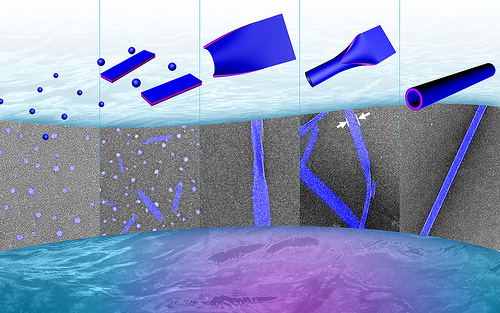
A team of Foundry users led by researchers from the Department of Energy’s Pacific Northwest National Laboratory, designed a tiny tube that rolls up and zips closed. These hollow nanotubes are thousands of times smaller than a strand of human hair and could help with water filtration, tissue engineering and many other applications.
Microtubules are tiny hollow tubes that help keep DNA organized during cell division and form highways for shuttling contents around in the cell. These cellular roads are composed of long chains of proteins that come together into a rigid, but hollow, tube.
The researchers hope to use tiny hollow tubes like microtubules to create a robust water filtration system that would catch salt or other molecules inside and let pure water escape out the other end. In addition, they want to monitor how stem cells adapt to different environments by studying how the cells change while they grow on these tubes. However, the researchers can’t use microtubules themselves for these projects. Microtubules may be rigid and responsive, but they’re also susceptible to temperature changes and microbes.
The team set about making a synthetic version of microtubules using protein-like molecules called peptoids. Like proteins, peptoids are composed of a repeating pattern of building blocks with slight variations, but peptoids are more stable.
These new nanotubes form in a unique way. First, small peptoid particles come together to form a sheet. Then the sheet closes at one end and rolls into a seamless tube.
To characterize the nanotubes, the scientists used a variety of techniques, including some at the Advanced Light Source and the Molecular Foundry.

